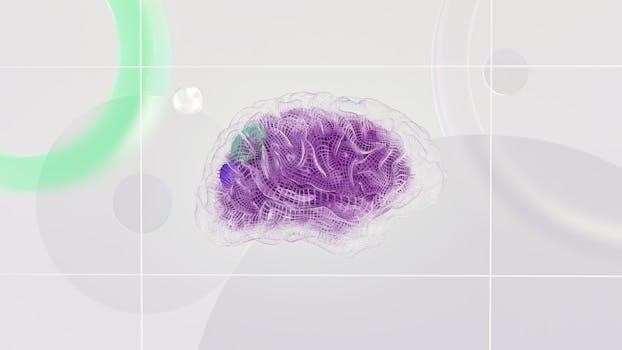Addiction is a complex brain disease impacting reward, motivation, memory circuits, leading to compulsive behavior. The addicted brain shows changes in areas controlling judgment, decision-making, and behavior. These changes alter brain function, highlighting addiction’s biological basis. Understanding this is key for effective interventions and treatment approaches.
Overview of Addiction as a Brain Disease
Addiction is recognized as a primary, chronic disease affecting the brain’s reward, motivation, and memory systems. This dysfunction results in individuals pathologically pursuing reward or relief through substance use and other behaviors. Brain imaging studies reveal physical changes in areas crucial for judgment, decision-making, learning, memory, and behavioral control. These alterations are not mere consequences of drug use, but rather, they contribute to the compulsive nature of addiction. The brain’s intricate network of neurons, communicating through electrical impulses, is significantly impacted, disrupting normal functioning. The reward system, particularly, is hijacked by substances, creating a powerful drive to seek them despite negative consequences. Understanding addiction as a brain disease is essential for developing effective treatment strategies that address the underlying neurological changes. This perspective emphasizes the need for approaches that go beyond willpower, focusing instead on the complex biological mechanisms at play.

The Neurological Basis of Addiction
Addiction stems from complex changes in the brain, impacting its reward system, structure, and function. Neurons play a vital role in transmitting signals, which are disrupted by substance abuse. These neurological shifts contribute to the compulsive behaviors and altered decision-making seen in addiction.
The Brain’s Reward System and Addiction
The brain’s reward system, a network of structures including the nucleus accumbens and the ventral tegmental area, is central to understanding addiction. This system is designed to reinforce behaviors essential for survival, such as eating and social interaction, by releasing dopamine, a neurotransmitter associated with pleasure and motivation. Drugs of abuse hijack this system, causing an artificial surge of dopamine, which leads to intense feelings of pleasure. Repeated drug use causes the brain to adapt to these artificial dopamine levels. The brain becomes less sensitive to natural rewards, making it more difficult to experience pleasure from everyday activities. This process is known as tolerance. The individual now needs more drugs to achieve the same high. This reinforces continued drug seeking behavior. The reward system also plays a crucial role in the development of cravings and withdrawal symptoms, further perpetuating the cycle of addiction. This system’s dysfunction highlights addiction as a chronic brain disease rather than a moral failing. Understanding this system is crucial for developing effective treatment strategies that address the root causes of addictive behavior.
Changes in Brain Structure and Function Due to Addiction
Chronic substance abuse triggers significant changes in both the structure and function of the brain. These alterations aren’t merely temporary effects; they can be long-lasting and contribute to the perpetuation of addiction. Brain imaging studies reveal alterations in areas crucial for decision-making, judgment, learning, and memory. The prefrontal cortex, responsible for executive functions, shows reduced activity and structural changes, impairing the ability to control impulses and make rational choices. Furthermore, the amygdala, which processes emotions, becomes hyperactive in addiction, leading to heightened emotional responses, especially during withdrawal. The hippocampus, involved in memory, can also be affected, contributing to the development of drug-related cues and memories that trigger relapse. These changes extend to white matter tracts, which are essential for communication between different brain regions. Disruption in white matter connectivity further impairs brain function. These changes collectively demonstrate that addiction is a brain disease characterized by profound neurobiological alterations. It is not just a matter of choice or willpower. Recognizing these structural and functional changes is important for developing targeted treatment strategies.
The Role of Neurons in Addiction
Neurons, the fundamental units of the brain, play a pivotal role in the development and maintenance of addiction. These cells communicate through electrical impulses and chemical neurotransmitters, forming complex neural networks. In addiction, drugs disrupt this normal communication, altering how neurons function. Specifically, substances of abuse often target the brain’s reward system, leading to a surge of dopamine, a neurotransmitter associated with pleasure and motivation. Over time, the repeated activation of these reward pathways leads to structural and functional changes in neurons. These changes include alterations in the number of receptors on the neuron’s surface, as well as changes in their sensitivity. Furthermore, chronic drug use can lead to a decrease in the natural production of dopamine, resulting in a state of anhedonia, where individuals experience diminished pleasure in everyday activities. This neuronal adaptation further drives the individual to seek drugs to restore dopamine levels and feel normal. The changes in neurons are not limited to the reward system; they also affect other areas of the brain, including those involved in memory, decision-making, and impulse control. This interplay of neurons and neurotransmitters underlies the compulsive nature of addiction. Recovery depends on the brain’s ability to restore neuronal function and connections.

Worksheet Applications and Tools
Worksheets provide valuable tools for self-reflection, exploring brain function, and education. They facilitate understanding of addiction’s neurological basis, aiding in recovery. Investigation worksheets delve into neural pathways, while project worksheets promote awareness through educational materials. These resources enhance learning.
Using Worksheets for Self-Reflection on Addiction

Worksheets designed for self-reflection on addiction offer a structured approach to understanding personal patterns and triggers. These tools encourage individuals to examine their behaviors, identify underlying causes, and explore the impact of substance use on their lives. Through guided questions and exercises, individuals can gain insights into their addictive tendencies, fostering a deeper understanding of their own experiences. These worksheets often incorporate elements of cognitive behavioral therapy, prompting users to challenge negative thought patterns and develop healthier coping mechanisms. Furthermore, self-reflection worksheets can facilitate the identification of personal strengths and resources that can support recovery journeys. By prompting introspection, they empower individuals to take an active role in their own healing process. The focus on personal accountability and insight makes these worksheets invaluable for promoting self-awareness and motivation for positive change. These tools also allow for tracking progress and identifying patterns that could lead to relapse, thus contributing to relapse prevention strategies. Ultimately, these worksheets provide a safe space for introspection and self-discovery, which is an essential step in the journey towards recovery.
Investigation Worksheets⁚ Exploring Brain Function
Investigation worksheets on brain function delve into the neurological underpinnings of addiction, providing a platform for deeper understanding. These worksheets often explore the intricate workings of neurons, the brain’s reward system, and how substances disrupt normal brain processes. They may include diagrams and activities that illustrate the impact of drugs on neurotransmitter pathways and the structural changes caused by addiction. By examining specific brain regions and their roles in addiction, users gain a clearer picture of the biological mechanisms at play. These worksheets can also introduce concepts like neuroplasticity, highlighting the brain’s ability to adapt and change. Users might explore case studies or scenarios that demonstrate how addiction affects different parts of the brain. Furthermore, these investigation worksheets may encourage individuals to conduct their own research, fostering a scientific approach to understanding addiction. By combining theory with practical application, these tools empower individuals to grasp the complexity of addiction at a neurological level. They help connect the abstract concepts of brain function to the concrete realities of addiction, promoting a more informed and empathetic view.
Project Worksheets⁚ Creating Educational Materials
Project worksheets focusing on creating educational materials offer a dynamic way to solidify understanding of addiction and the brain. These worksheets guide users in developing posters, presentations, pamphlets, or even short videos that explain the science behind addiction. They often encourage collaborative work, enabling peer-to-peer learning and discussion. These projects require users to synthesize complex information into accessible formats, fostering deeper comprehension. By creating educational resources, individuals not only learn the material but also develop communication skills, crucial for raising awareness about addiction. Project worksheets may provide templates or guidelines for content, ensuring accurate representation of scientific concepts. They might also encourage users to integrate visual aids, such as diagrams of brain structures or infographics on neurotransmitter pathways. This hands-on approach promotes active learning and critical thinking, making the science of addiction more engaging and impactful. Furthermore, these worksheets often include assessment criteria, ensuring the projects effectively convey information to a target audience, thus enhancing educational outreach about addiction.

Recovery and Treatment
Recovery involves rebuilding brain connections disrupted by addiction. Treatment strategies focus on addressing these changes. Understanding brain alterations helps tailor effective interventions. Tools for screening and assessment are vital in identifying substance use issues and guiding appropriate treatment paths.
Rebuilding Brain Connections in Recovery
Recovery from addiction is not just about stopping substance use; it’s a journey of rebuilding the intricate networks within the brain that have been altered by addiction. The process involves strengthening weakened neural pathways and forging new connections. This is because addiction impacts areas of the brain crucial for decision-making, memory, and impulse control, leading to behavioral changes. The brain’s remarkable plasticity allows for this rebuilding process. Strategies like therapy, support groups, and lifestyle changes promote the growth of healthy neural connections. By engaging in activities that stimulate the brain, individuals in recovery can help restore balance to the affected areas. It’s a process that requires time, patience, and a commitment to long-term health. The goal is to rewire the brain, enabling healthier responses and reducing the risk of relapse. This involves strengthening alternative pathways, fostering self-awareness and coping skills, and creating a foundation for sustained well-being. The journey may be challenging, but the brain’s capacity to adapt and heal provides great hope for full recovery. This process is not about replacing old brain cells, but about strengthening existing connections between them.
Understanding Brain Changes and Treatment Strategies
Addiction causes significant changes in the brain’s structure and function, influencing behavior and decision-making processes. These changes primarily occur in areas associated with reward, motivation, learning, and memory. Understanding these neurological shifts is crucial for developing effective treatment strategies. Chronic substance use can lead to a reduction in gray matter volume and altered connectivity between brain regions. Treatment approaches aim to restore balance in the brain by promoting neuroplasticity. Therapy, such as cognitive-behavioral therapy, helps individuals develop new coping skills and break the cycle of addiction. Medications can also play a role by addressing withdrawal symptoms and reducing cravings. Furthermore, lifestyle changes, including regular exercise and a healthy diet, can positively impact brain health. By understanding how addiction affects the brain, clinicians can tailor treatment plans to meet individual needs. The goal is to address both the physical and psychological aspects of addiction, working towards long-term recovery. Treatment is a process that acknowledges the brain’s capacity to adapt and heal, but it is essential to provide ongoing support and monitoring to prevent relapse. This approach involves acknowledging the complex interplay between brain changes and addictive behaviors.
Screening Tools and Assessment for Substance Use
Identifying substance use disorders early is crucial for effective intervention, and various screening tools play a vital role in this process. These tools help assess the risk and presence of substance use problems through questionnaires and interviews. One commonly used tool is the CAGE questionnaire, which is designed to identify potential alcohol dependence. The TAPS tool is another option that screens for tobacco, alcohol, prescription, and street drug use. The Opioid Risk Tool is specifically designed to assess the risk of opioid misuse and addiction. These tools are typically short and easy to administer, making them convenient for use in various settings. However, it’s important to note that these screenings are not diagnostic, but rather a starting point for more comprehensive assessment. A positive screen often indicates the need for further evaluation by a healthcare professional. More detailed assessments may include a thorough clinical interview, psychological evaluations, and physical examinations. The goal of assessment is to gain a comprehensive understanding of an individual’s substance use history, current symptoms, and underlying conditions. These tools and assessments help healthcare providers tailor treatment plans to meet each individual’s needs, promoting a more focused and effective recovery journey.
